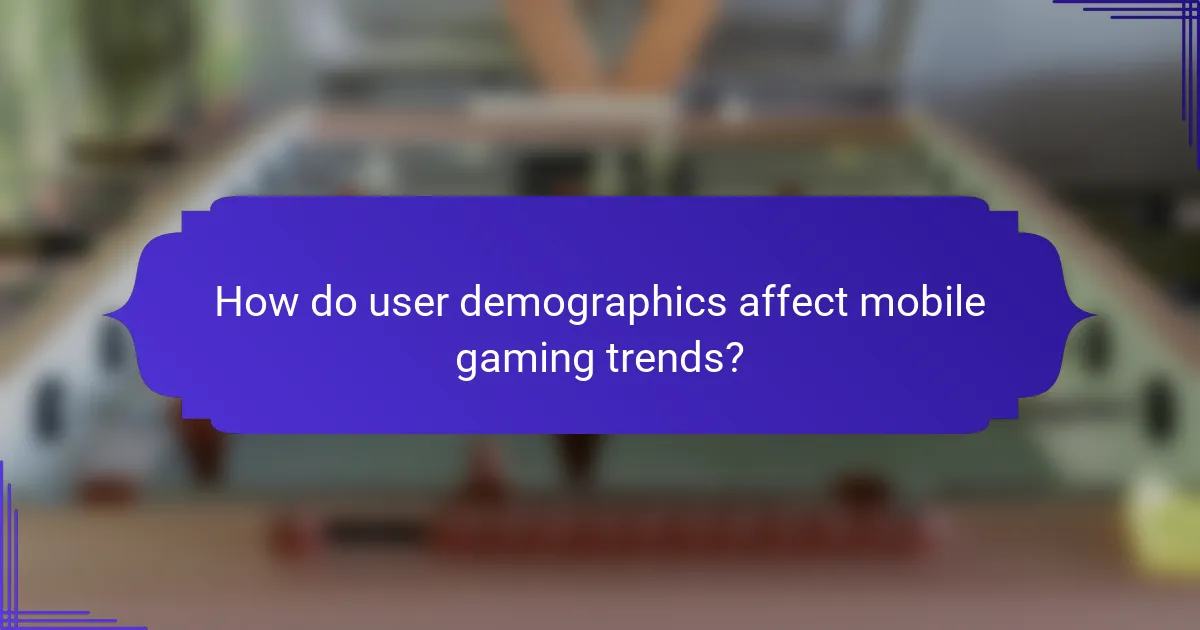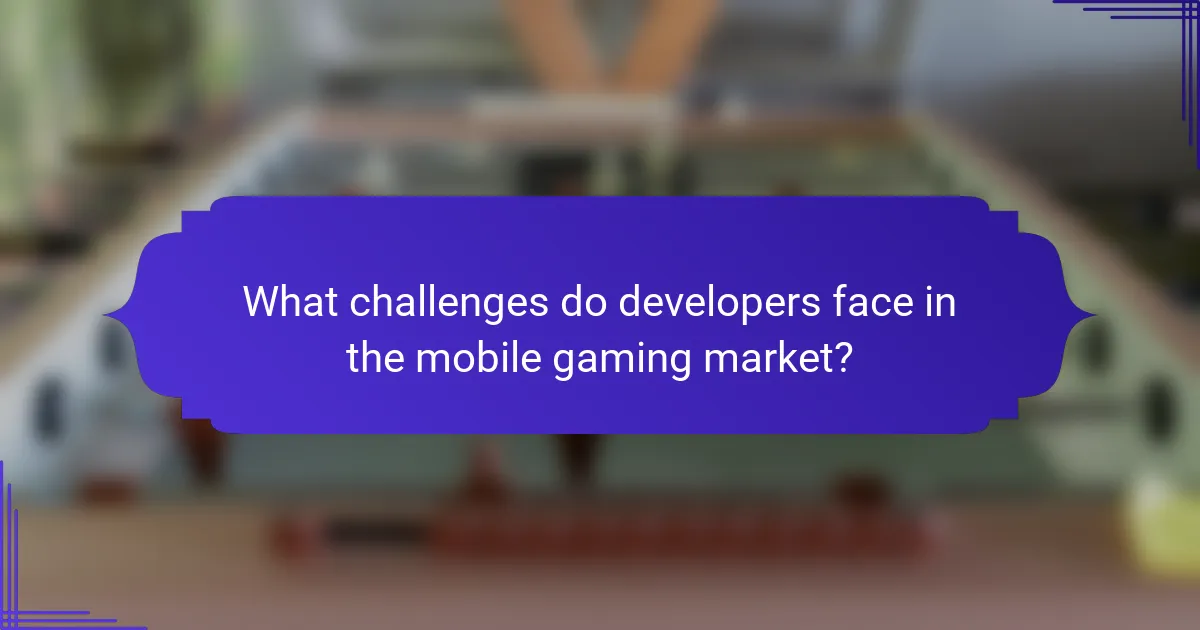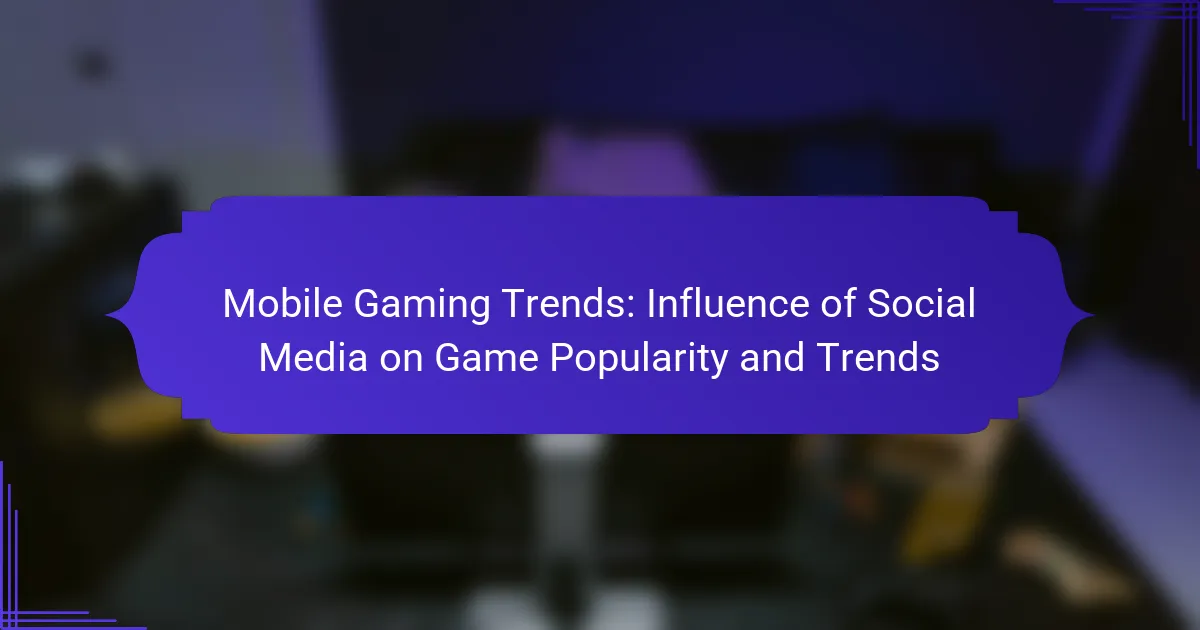Mobile gaming trends are increasingly influenced by social media, impacting game popularity and user engagement. Platforms like TikTok and Instagram drive discovery through viral marketing and user-generated content. Enhanced social connectivity, adaptive gameplay, and cutting-edge graphics are shaping the gaming landscape. Additionally, demographic factors play a crucial role in defining player preferences and engagement strategies.

How does social media impact mobile game discovery and popularity?
Social media significantly boosts mobile game discovery and popularity through user engagement and viral marketing. Platforms like Instagram and TikTok allow developers to showcase gameplay, driving interest and downloads. User-generated content, such as reviews and gameplay videos, influences potential players’ decisions. Additionally, social media campaigns can create buzz around new releases, enhancing visibility and attracting wider audiences. As a result, games that leverage social media effectively often experience rapid growth and sustained popularity.
Which platforms are most effective for promoting mobile games?
Social media platforms like Facebook, Instagram, and TikTok are most effective for promoting mobile games. These platforms leverage user engagement and visual content to create buzz around new releases. TikTok’s short video format drives viral trends, while Instagram’s visuals showcase gameplay. Facebook groups foster community discussions, enhancing word-of-mouth marketing. As a result, mobile games gain visibility and attract more players through targeted advertising and influencer partnerships.
What role do influencers play in mobile gaming trends?
Influencers significantly shape mobile gaming trends by driving awareness and engagement. Their reach on social media platforms allows them to promote new games, often leading to viral popularity. For example, influencers can showcase gameplay, share reviews, and offer exclusive content, which attracts their followers to try these games. As a result, mobile games that receive influencer endorsements often see a spike in downloads and user engagement. This trend highlights the importance of social media in the mobile gaming landscape, where influencers serve as key drivers of game popularity.

What are the key features of popular mobile games in 2025?
In 2025, popular mobile games feature enhanced social connectivity, immersive graphics, and adaptive gameplay. These trends are shaped by social media’s influence on user engagement and community-building.
Mobile games increasingly integrate social media platforms, allowing players to share achievements and connect with friends easily. This connectivity fosters a sense of community, enhancing user retention.
Adaptive gameplay is another key feature, as games tailor experiences based on player behavior and preferences. This personalization keeps players engaged and encourages longer play sessions.
Finally, cutting-edge graphics and augmented reality elements elevate the gaming experience, making mobile games visually appealing and immersive. These features collectively drive popularity and trends in the mobile gaming landscape.
How do game mechanics influence player engagement?
Game mechanics significantly enhance player engagement by creating immersive experiences and fostering competition. Features like rewards, challenges, and social interactions encourage players to invest time and effort. For instance, leaderboards and achievements motivate players to improve their skills and share progress on social media, amplifying game visibility. Additionally, narrative elements and progression systems keep players emotionally connected, increasing retention rates. Overall, effective game mechanics align with social media trends to boost popularity and player involvement.
What genres are trending in mobile gaming this year?
Mobile gaming trends this year highlight the dominance of battle royale, augmented reality, and casual games. Social media significantly influences game popularity, driving engagement through viral challenges and community interaction. Platforms like TikTok amplify trends, showcasing gameplay and fostering user-generated content. As a result, developers focus on social features and shareable experiences to attract players.

How do user demographics affect mobile gaming trends?
User demographics significantly shape mobile gaming trends by influencing preferences and engagement. Younger audiences favour social media platforms, driving trends through viral content. For example, games like “Among Us” gained popularity via TikTok and Instagram. Additionally, demographic factors such as age, gender, and geographic location affect game features, marketing strategies, and monetization methods. As a result, developers tailor experiences to meet the specific interests of diverse user groups, enhancing player retention and satisfaction.
Which age groups are most engaged with mobile games?
The most engaged age groups with mobile games are typically between 18 and 34 years old. This demographic shows high participation due to social media influence and peer interaction. Additionally, users aged 35 to 44 are also significantly engaged, often driven by nostalgia and social connectivity. As a result, mobile gaming trends reflect a strong preference among younger audiences while still appealing to older players.
How does gender influence gaming preferences on mobile?
Gender significantly influences mobile gaming preferences, affecting game genres and social interactions. Research indicates that male players often prefer action and competitive games, while female players gravitate towards social and casual games.
Social media impacts these trends by shaping community dynamics and game visibility. For instance, platforms like Instagram and TikTok promote games through influencers, attracting diverse audiences. Gender representation in gaming content can also affect engagement levels, with female gamers responding positively to relatable characters and narratives.
Moreover, the gaming industry is increasingly recognizing these preferences, leading to the development of games that cater to varied interests. As a result, understanding gender influences can help developers create more inclusive gaming experiences that resonate with a broader audience.

What are the unique attributes of successful mobile games?
Successful mobile games often feature unique attributes that enhance their appeal and engagement. These attributes include innovative gameplay mechanics, captivating storytelling, and strong social connectivity.
Innovative gameplay mechanics, such as unique control schemes or interactive elements, set successful games apart. Captivating storytelling creates an emotional connection, driving player investment. Strong social connectivity allows players to share experiences, enhancing community and competition.
The integration of these attributes can lead to higher retention rates and increased virality through social media platforms. For example, games that encourage sharing achievements or collaborating with friends often see a boost in popularity.
In summary, the unique attributes of successful mobile games revolve around gameplay innovation, engaging narratives, and robust social features. These elements collectively contribute to a game’s lasting success in the competitive mobile gaming landscape.
How do in-game social features enhance player retention?
In-game social features significantly enhance player retention by fostering community engagement and interaction. These features, such as chat systems and social sharing options, create a sense of belonging among players. As a result, players are more likely to return to the game regularly.
Additionally, social features enable players to form alliances or teams, which can lead to cooperative gameplay experiences. This collaborative aspect encourages players to stay connected and engaged over time. Games that incorporate these social elements often see improved player loyalty and longer session durations.
Moreover, user-generated content sharing through social media platforms amplifies the game’s visibility and appeal. Players sharing their achievements or experiences can attract new users, further enhancing the game’s popularity and retention rates. Overall, the integration of social features plays a crucial role in maintaining an active player base.
What innovative monetization strategies are being used?
Mobile gaming is increasingly leveraging innovative monetization strategies to enhance revenue streams. In-game advertising, particularly through social media partnerships, allows developers to integrate ads seamlessly, boosting user engagement. Subscription models provide consistent revenue by offering exclusive content, while in-app purchases enable players to enhance their experience with unique items. Collaborations with influencers on platforms like TikTok and Instagram drive game visibility and adoption, creating a direct link between social media presence and monetization success. Additionally, user-generated content encourages community involvement, increasing retention and monetization opportunities.

What challenges do developers face in the mobile gaming market?
Developers face several challenges in the mobile gaming market, primarily driven by social media influence. Competition is intense, with numerous games vying for attention. User acquisition costs are rising due to targeted advertising on social platforms. Keeping up with rapidly changing trends and player preferences is essential. Developers must also navigate platform restrictions and monetization strategies effectively. Additionally, maintaining user engagement in a saturated market poses a significant hurdle.
How do privacy concerns affect user engagement with mobile games?
Privacy concerns significantly reduce user engagement with mobile games. Players often hesitate to share personal data, fearing misuse or breaches. This leads to a decline in social interactions and community building, which are crucial for mobile game popularity. As a result, developers need to prioritize transparency and data protection to enhance user trust and engagement.
What common pitfalls should developers avoid in game design?
Developers should avoid common pitfalls like neglecting user feedback, overlooking mobile optimization, and failing to integrate social media features. These mistakes can hinder game popularity and player engagement.
Neglecting user feedback can lead to a disconnect between the game and its audience. Regularly collecting and implementing feedback fosters a more engaging experience.
Overlooking mobile optimization affects performance on various devices. Developers must ensure games run smoothly across different screen sizes and operating systems to reach a broader audience.
Failing to integrate social media features limits a game’s potential virality. Features like sharing achievements or inviting friends can significantly enhance visibility and player retention.

What future trends should we expect in mobile gaming?
Mobile gaming will increasingly leverage social media for user engagement and virality. Platforms like TikTok and Instagram drive trends through user-generated content, influencing game popularity. This method enhances community interaction and fosters trends like live streaming gameplay. Additionally, social media integration will facilitate in-game purchases and real-time updates, creating a dynamic gaming ecosystem. As a result, developers will prioritize social features in game design to capitalize on these trends.
How will advancements in technology shape mobile gaming experiences?
Advancements in technology will significantly enhance mobile gaming experiences by integrating social media functionalities. These features facilitate community engagement, enabling players to share achievements and strategies instantly. Enhanced graphics and augmented reality will further immerse users, creating more interactive environments. As a result, the popularity of mobile games will likely surge, driven by social connectivity and innovative gameplay.
What emerging social media trends could influence gaming?
Emerging social media trends significantly influence mobile gaming popularity and trends. Platforms like TikTok and Instagram are driving user engagement through short-form content and viral challenges, making games more visible.
User-generated content is becoming crucial, as gamers share experiences and strategies, enhancing community interaction. This trend boosts game visibility and attracts new players, reflecting a shift towards social engagement in gaming.
Cross-platform play is gaining traction, supported by social media interactions. Gamers can connect and compete across devices, expanding their reach and fostering a more inclusive gaming environment.
Live streaming on platforms like Twitch is reshaping game promotion. Influencers showcase gameplay, creating authentic connections with audiences, which drives game downloads and active participation.
What best practices should developers follow for social media integration?
Developers should prioritize user experience, data privacy, and seamless functionality in social media integration. First, ensure that social sharing features are intuitive and easily accessible within the game interface. Second, adhere to data protection regulations to safeguard user information. Third, utilize APIs effectively for smooth integration of social media features, enhancing gameplay through sharing achievements and connecting with friends. Lastly, monitor user feedback to continuously improve integration strategies, adapting to evolving social media trends.
